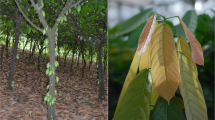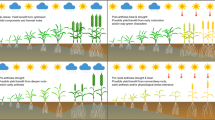Abstract
We tested for genetic variation in light response curves and their acclimation to sun versus shade in recombinant inbred lines (RILs) of the annual species Impatiens capensis derived from a cross between sun and shade populations. We exposed replicates of 49 RILs to experimentally manipulated light levels (open versus shade) in a greenhouse and measured photosynthetic light response curves, height, biomass, and reproduction. Plants were taller in the shade treatment, but we were unable to detect differences between light treatments (i.e., acclimation) in the maximal rate of photosynthesis, the light compensation point, or the quantum efficiency of photosynthesis. Genotypic selection analyses indicated that higher maximal rates of carbon assimilation and higher light compensation points (typical of sun-acclimated light curves) were favored by natural selection in both light treatments. Thus, it appears that the pattern of selection on photosynthetic parameters may not depend on light environment in this species.


Similar content being viewed by others
References
Argyres AZ, Schmitt J (1991) Microgeographic genetic structure of morphological and life history traits in a natural population of Impatiens capensis. Evolution 45:178–189
Arnold SJ, Peterson CR (2002) A model for optimal reaction norms: the case of the pregnant garter snake and her temperature-sensitive embryos. Am Nat 160:306–316
Arntz AM, Delph LF (2001) Pattern and process: evidence for the evolution of photosynthetic traits in natural populations. Oecologia 127:455–467
Baskauf CJ, Eickmeier WG (1994) Comparative ecophysiology of a rare and a widespread species of Echinacea (Asteraceae). Am J Bot 81:958–964
Bennington CC, McGraw JB (1995) Natural selection and ecotypic differentiation in Impatiens pallida. Ecol Monogr 65:303–323
Buchmann N, Brooks JR, Rapp KD, Ehleringer JR (1996) Carbon isotope composition of C-4 grasses influenced by light and water supply. Plant Cell Environ 19:392–402
Chazdon RL, Pearcy RW (1986) Photosynthetic responses to light variation in rainforest species. II. Carbon gain and photosynthetic efficiency during light flecks. Oecologia 69:524–531
Chazdon RL (1992) Photosynthetic plasticity of two rain forest shrubs across natural gap transects. Oecologia 92:586–595
Clough JM, Peet MM, Kramer PJ (1981) Effects of high atmospheric CO2 and sink size on rates of photosynthesis of a soybean cultivar. Plant Physiol 67:1007–1010
Davies SJ (1998) Photosynthesis of nine pioneer Macaranga species from Borneo in relation to life history. Ecology 79:2292–2308
Donohue K, Messiqua D, Hammond Pyle E, Heschel MS, Schmitt J (2000) Evidence of adaptive divergence in plasticity: density- and site-dependent selection on shade avoidance responses in Impatiens capensis. Evolution 54:1956–1968
Donohue K, Hammond Pyle E, Messiqua D, Heschel MS, Schmitt J (2001) Adaptive divergence in plasticity in natural populations of Impatiens capensis and its consequences for performance in novel habitats. Evolution 55:692–702
Dudley SA (1996) Differing selection on plant physiological traits in response to environmental water availability: a test of adaptive hypotheses. Evolution 50:92–102
Dudley SA, Schmitt J (1996) Testing the adaptive plasticity hypothesis: density-dependent selection on manipulated stem length in Impatiens capensis. Am Nat 147:445–465
Ehleringer JR (1978) Implications of quantum yield differences on the distributions of 3 carbon and 4 carbon grasses. Oecologia 31:255–268
Farquhar GD, Sharkey TD (1982) Stomatal conductance and photosynthesis. Annu Rev Plant Physiol 33:317–345
Farris MA, Lechowicz MJ (1990) Functional interactions among traits that determine reproductive success in a native annual plant. Ecology 71:548–557
Field CB (1988) On the role of photosynthetic responses in contrasting the habitat distribution of rainforest plants. Aust J Plant Physiol 15:343–358
Garbutt K (1986) Genetic differentiation in leaf and whole plant photosynthetic capacity and unit leaf rate among clones of Phlox paniculata. Am J Bot 73:1364–1371
Geber MA, Dawson TE (1990) Genetic variation in and co-variation between leaf gas exchange, morphology, and development in Polygonum arenastrum, an annual plant. Oecologia 85:153–158
Geber MA, Dawson TE (1997) Genetic variation in stomatal and biochemical limitations to photosynthesis in the annual plant, Polygonum arenastrum. Oecologia 109:535–546
Givnish TJ (1988) Adaptation to sun and shade: a whole plant perspective. Aust J Plant Physiol 15:63–92
Hacker SD, Bertness MD (1995) Morphological and physiological consequences of a positive plant interaction. Ecology 76:2165–2175
Heschel MS, Hausmann NJ (2001) Population differentiation for abscisic acid sensitivity in response to drought in Impatiens capensis (Balsaminaceae). Int J Plant Sci 162:1253–1260
Heschel MS, Donohue K, Hausmann NJ, Schmitt J (2002) Population differentiation and natural selection for water-use efficiency in Impatiens capensis (Balsaminaceae). Int J Plant Sci 163:907–912
Hirose T, Werger MJA (1987) Maximizing daily canopy photosynthesis with respect to the leaf nitrogen allocation pattern in the canopy. Oecologia 72:520–526
Kirkpatrick M, Lofsvold D, Bulmer M (1990) Analysis of the inheritance, selection, and evolution of growth trajectories. Genetics 124:979–993
Kingsolver JG, Gomulkiewicz RS, Carter PA (2001) Variation, selection, and evolution of function-valued traits. Genetica 112–113:87–104
Lambers H, Chapin FS III, Pons TL (1998) Plant physiological ecology. Springer, Berlin Heidelberg New York
Lande R, Arnold SJ (1983) The measurement of selection on correlated characters. Evolution 37:1210–1226
Larcher W (1995) Physiological plant ecology, 3rd edn. Springer, Berlin Heidelberg New York
Littell RC, Milliken GA, Stroup WW, Wolfinger RD (1996) SAS System for Mixed Models. SAS Institute, Cary
Littell RC, Henry PR, Ammerman CB (1998) Statistical analysis of repeated measures data using SAS procedures. J Anim Sci 76:1216–1231
Marshall B, Biscoe PV (1980) A model for 3 carbon leaves describing the dependence of net photosynthesis on irradiance derivation. J Exp Bot 31:29–40
Mooney HA (1991) Plant physiological ecology—determinants of progress. Funct Ecol 5:127–135
Mooney HA, Field C, Gulmon SL, Bazzaz FA (1981) Photosynthesis capacity in relation to leaf position in desert vs. old field annuals. Oecologia 50:109–112
Mulkey SS, Smith AP, Wright SJ (1991) Comparative life-history and physiology of 2 understory neotropical herbs. Oecologia 88:263–273
Paoletti C, Holsinger KE (1999) Spatial patterns of polygenic variation in Impatiens capensis, a species with an environmentally controlled mixed mating system. J Evol Biol 12:689–696
Parkinson KJ (1985) A simple method for determining the boundary layer resistance in leaf cuvettes. Plant Cell Environ 8:223–226
Pearcy RW, Sims DA (1994) Photosynthetic acclimation to changing light environments: scaling from the leaf to the whole plant. In: Caldwell MM, Pearcy RW (eds) Exploitation of environmental heterogeneity by plants: ecophysiological processes above- and belowground. Academic, San Diego, pp 145–174
Peek MS, Russek-Cohen E, Wait DA, Forseth IN (2002) Physiological response curve analysis using nonlinear mixed models. Oecologia 132:175–180
Potvin C, Lechowicz MJ, Tardif S (1990) The statistical analysis of ecophysiological response curves obtained from experiments involving repeated measures. Ecology 71:1389–1400
Rausher MD (1992) The measurement of selection on quantitative traits: biases due to environmental covariances between traits and fitness. Evolution 46:616–626
Scheiner SM, Gurevitch J, Teeri JA (1984) A genetic analysis of the photosynthetic properties of populations of Danthonia spicata that have different growth responses to light level. Oecologia 64:74–77
Schemske DW (1984) Population structure and local selection in Impatiens pallida (Balsaminaceae), a selfing annual. Evolution 38:817–832
Schmitt J (1993) Reaction norms of morphological and life-history traits to light availability in Impatiens capensis. Evolution 47:1654–1668
Schoen DJ, Latta RG (1989) Spatial autocorrelation of genotypes in populations of Impatiens pallida and Impatiens capensis. Heredity 63:181–189
Schoen DJ, Stewart SC Lechowicz MJ, Bell G (1986) Partitioning the transplant site effect in reciprocal transplant experiments with Impatiens capensis and Impatiens pallida. Oecologia 70:149–154
Schulz KE, Smith M, Wu Y (1993) Gas exchange of Impatiens pallida Nutt. (Balsaminaceae) in relation to wilting under high light. Am J Bot 80:361–368
Sims DA, Kelley S (1998) Somatic and genetic factors in sun and shade population differentiation if Plantago lanceolata and Anthoxanthum odoratum. New Phytol 140:75–84
Stinchcombe JR, Rausher MD (2001) Diffuse selection on resistance to deer herbivory in the Ivyleaf Morning glory, Ipomoea hederacea. Am Nat 158:376–388
Stinchcombe JR, Rutter MT, Burdick DS, Tiffin P, Rausher MD, Mauricio R (2002) Testing for environmentally induced bias in phenotypic estimates of natural selection: theory and practice. Am Nat 160:511–523
Sultan SE, Bazzaz FA (1993) Phenotypic plasticity in Polygonum persicaria. I. Diversity and uniformity in genotypic norms of reaction to light. Evolution 47:1009–1031
Teramura AH, Strain BR (1979) Localized populational differences in the photosynthetic response to temperature and irradiance in Plantago lanceolata. Can J Bot 57:2559–2563
Thornley JHM (1976) Mathematical models in plant physiology. Academic, New York
Valladares F, Wright SJ, Lasso E, Kitajima K, Pearcy RW (2000) Plastic phenotypic response to light of 16 congeneric shrubs from a Panamanian rainforest. Ecology 81:1925–1936
Waller DM (1984) Differences in fitness between seedlings derived from cleistogamous and chasmogamous flowers in Impatiens capensis. Evolution 38:427–440
Wulff RD (1989) The effects of reduced irradiance and low red to far red ratios on the growth and photosynthetic capacity in Impatiens capensis (Abstract 350). Am J Bot 76(Suppl):S131–S132
Acknowledgements
We thank A. Aguilera, B. Leib, and F. Jackson for help in maintaining our inbred lines and superb plant care. We are grateful to H. Urabe and M. Jackson for experimental assistance, and J. Kelley for discussions about non-linear curve fitting. Our research has been supported by NSF grant DEB 0129018.
Author information
Authors and Affiliations
Corresponding author
Additional information
M. Shane Heschel and John R. Stinchcombe contributed equally to the paper.
Rights and permissions
About this article
Cite this article
Heschel, M.S., Stinchcombe, J.R., Holsinger, K.E. et al. Natural selection on light response curve parameters in the herbaceous annual, Impatiens capensis . Oecologia 139, 487–494 (2004). https://doi.org/10.1007/s00442-004-1553-z
Received:
Accepted:
Published:
Issue Date:
DOI: https://doi.org/10.1007/s00442-004-1553-z




